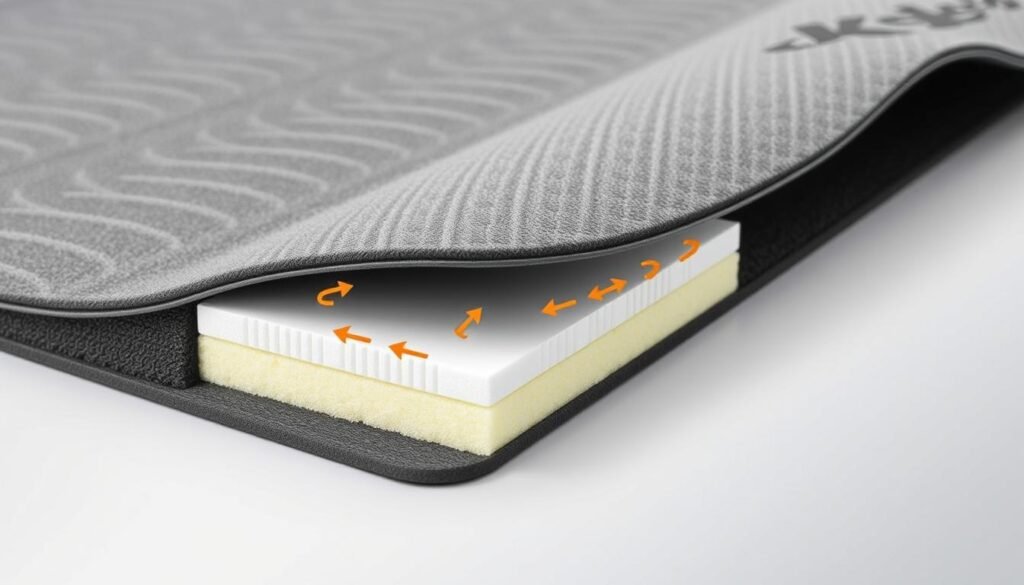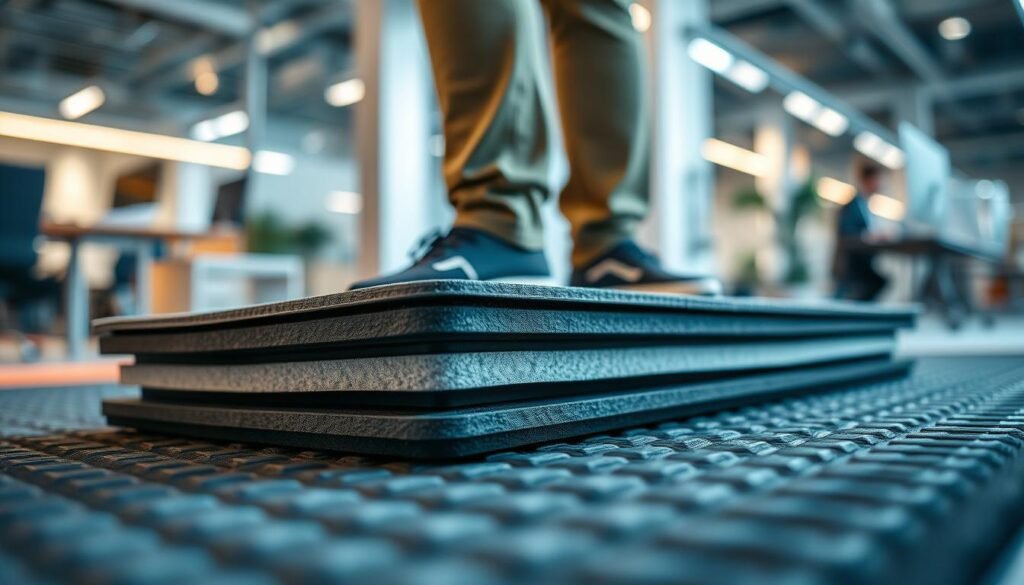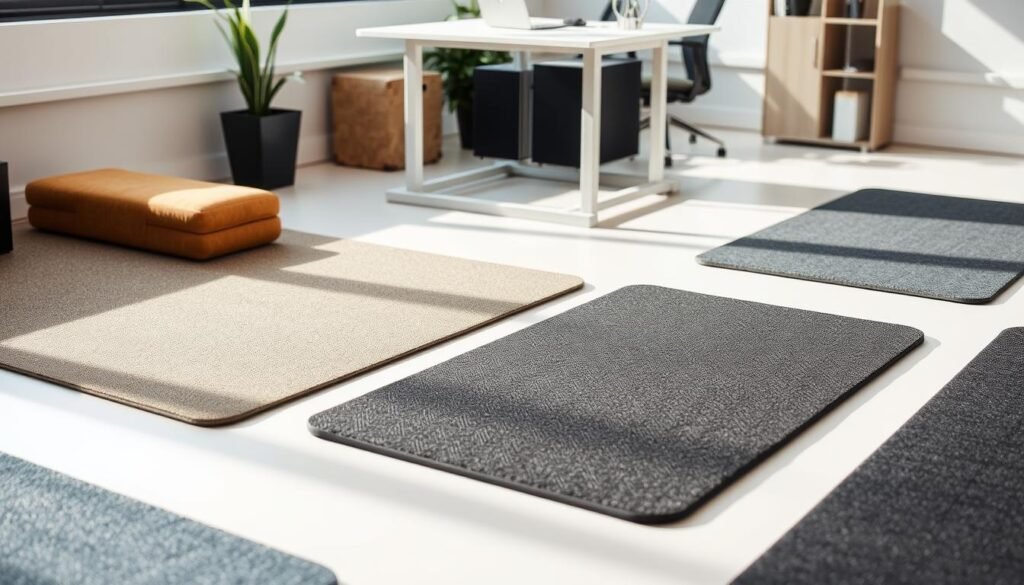Did you know that when businesses focus on their employees’ well-being they see a 20% increase in productivity? This important fact shows how much employee comfort affects their work. Standing too much at work can cause fatigue, joint pain, and backaches, possibly leading to injuries. That’s why it’s crucial to understand how anti-fatigue mats help improve comfort and productivity at work.
These mats are made for spots where people stand a lot. They offer much-needed cushioning and support. They help with blood flow and reduce pain, keeping workers feeling good as they work. Plus, anti-fatigue mats not only make employees more comfortable but also happier and more likely to stay with the company. For more info on how these mats work and their benefits, visit this resource.
Key Takeaways
- Investing in anti-fatigue mats can significantly enhance overall workplace comfort.
- Prolonged standing contributes to fatigue and discomfort, impacting job performance.
- Anti-fatigue mats facilitate micro-movements that promote better circulation.
- Using these mats can lead to lower turnover rates and improved employee morale.
- Proper selection and use of anti-fatigue mats can minimize risks of workplace injuries.
Understanding Anti-Fatigue Mats
Anti-fatigue mats are important in many work areas. They make standing more comfortable and lessen tiredness. Definition of anti-fatigue mats shows they help people who stand a lot feel better. They boost blood flow and support the body, which is good for health.
Definition and Purpose
The main purpose of anti-fatigue mats is to cushion and support feet. This eases the pressure from standing a lot. Studies show standing too much needs 20% more energy than sitting. In places like these, mats make a big difference. They improve work output and lower injury chances. To really get how these mats help, look at the importance of anti-fatigue mats.
Common Uses in Various Industries
Many industries use these mats. Key areas are:
- Manufacturing: Workers stand on hard floors, so they need mats to reduce stress.
- Retail: Cashiers and salespeople get more comfort during long stand-up hours.
- Healthcare: Doctors and nurses stand a lot, which tires them. Mats can help them work better.
- Hospitality: Restaurant and hotel staff need strong mats for comfort and safety.
Picking the suitable anti-fatigue mats is essential. Think about thickness, material, slip-resistance, and how easy they are to clean. These factors help them work well in making standing jobs more comfortable and less tiring.
How Anti-Fatigue Mats Work
Anti-fatigue mats play a big role in making sure we’re comfortable while standing for a long time. They are designed to give a soft surface. This allows for small changes in how we stand.
Mechanism of Action
Anti-fatigue mats help blood move around better. When you stand on them, you naturally shift your weight a bit. This keeps the blood flowing. These little movements spread your weight out, easing pressure on your feet, legs, and lower back. Studies have shown that using these mats can cut fatigue in half this makes them very helpful for standing long periods.
Encouraging Micro-Movements
Small movements are key to staying energetic all day. Standing takes more energy than sitting, so having help is crucial. Anti-fatigue mats make you move in small ways. This helps blood flow better and prevents joint pain and varicose veins. People who use these mats feel less tired and can do more. This shows how important these mats are for jobs that involve a lot of standing.

| Aspect | Impact |
|---|---|
| Fatigue Reduction | Up to 50% lower discomfort levels |
| Energy Utilization | 20% more energy is used when standing |
| Conditions Improved | Reduces risk of joint pain, heart disease, varicose veins |
| Warranties | Standard anti-fatigue mats come with a 15-year warranty |
Benefits of Anti-Fatigue Mats in the Workplace
More and more, employers understand how vital a productive workspace is. They see how anti-fatigue mats make the workplace more comfortable. This increases worker happiness and their work output.
Improved Comfort and Reduced Fatigue
Anti-fatigue mats offer a soft spot for standing. This cuts down on the discomfort from standing too long. Feeling better means less tiredness. In fact, studies show these mats can cut fatigue by up to 50%. So, workers can do their jobs better, without the nagging pain.
Enhanced Productivity
When people are more comfortable, they do their jobs better. Feeling less tired, they can focus more. So, they get more done. With less discomfort, they’re more into their work, pushing up productivity.
Decreased Risk of Injury
Anti-fatigue mats are great for making the workplace safer. They often have non-slip textures to help prevent falls. They also ease the pressure on joints and muscles, including the back and legs. This means fewer musculoskeletal problems, so workers stay healthier.
Increased Employee Satisfaction
When work feels better, employees are happier. Investing in things like anti-fatigue mats shows a company cares. Happy workers mean a strong, positive work culture. This leads to better morale and more employees sticking around.
| Benefits | Description |
|---|---|
| Improved Comfort | Reduces fatigue, allowing for longer periods of comfortable standing. |
| Enhanced Productivity | Increases focus and output levels among employees. |
| Decreased Injury Risk | Minimizes slips, falls, and strain-related injuries. |
| Increased Employee Satisfaction | Promotes a positive work environment and higher retention rates. |
Anti-Fatigue Mat Technology
Anti-fatigue mat technology is a big step forward for workplace comfort and health. It uses different materials and new features. This makes these mats important for staying comfortable when standing for a long time. Learning about the materials and how these mats are made helps us understand why they’re effective and last long.
Materials and Construction
The choice of materials is key in making anti-fatigue mats. Common materials include:
- High-density foam: It gives great cushioning, easing pressure on the joints.
- Rubber: Is tough and stands up well to use, especially in places like factories.
- Gel: Makes mats more comfortable by shaping to the body and helping keep you stable.
These materials help make a mat that’s both comforting and suitable for different work places. The design usually includes beveled edges. This helps reduce the chance of tripping, making the workplace safer.
Innovative Designs and Features
Next to quality materials, new features of anti-fatigue mats add to their usefulness. Some important updates include:
- Non-slip surfaces: These make the mats safer by stopping slips, important in busy spots.
- Antimicrobial treatments: Keep the workplace clean by fighting bacteria and allergens.
- Cushioning technology: This helps you make small movements, which improves blood flow and reduces tiredness.
Thanks to these new ideas, anti-fatigue mats serve well in all kinds of places, improving safety and comfort at work. 
Choosing the Right Anti-Fatigue Mat
It’s crucial to pick the best anti-fatigue mat to stay comfortable when standing for a long time. Knowing what to look for and the different kinds of mats can help. This ensures you make a great choice for comfort and benefits in your workspace.
Factors to Consider
Several key points are important when selecting an anti-fatigue mat:
- Thickness: Thin mats like those that are 1/4″ or 3/8″ thick don’t help much. Mats that are 3/4″ thick are usually just right.
- Material: The mat’s softness affects how comfortable it is. If it’s too soft or too hard, it won’t work well.
- Grip: The mat needs the right amount of traction. It should be stable, yet easy to move.
- Edges: Mats with sloped edges help prevent tripping.
- Aesthetics: Mats come in different colors and styles. Choosing one that fits your space can make it look better.
Common Types and Their Uses
Different anti-fatigue mats have specific purposes:
- Flat Mats: Great for offices where you stand now and then.
- Heavy-Duty Mats: These are for places like factories, where you stand a lot in shoes.
- Kitchen Mats: Perfect for cooking areas. There are mats for short-term use, ideal for working in socks.
- Specialty Mats: Some mats are made just for hospitals. They last a long time and are easy to clean.

Anti-Fatigue Mat Features
Key anti-fatigue mat features boost comfort and support health for those who stand often. Thickness and cushioning make standing more enjoyable. They have different thickness levels for various needs, helping fight fatigue during long work hours.
Thickness and Cushioning
Thickness is important for anti-fatigue mats because it determines cushioning. Thicker mats offer more cushion, which is vital for long-standing periods. This can cut fatigue by half, easing workdays. Mats with advanced cushioning help ease joint pressure and improve posture, making ergonomic workspaces better.
Ergonomic Support
Ergonomic support is key for these mats. They adjust to weight distribution, aiding in balance and alignment. This reduces strain on the back and legs and boosts blood flow with small movements. Non-slip surfaces also make mats safer, keeping them fixed. For more info on choosing the right mat, visit anti-fatigue mat features.
Why Use Anti-Fatigue Mats?
Anti-fatigue mats bring many benefits to those who use them. They are essential for comfort and health in the workplace. They help in different industries by supporting workers’ well-being.
Long-Term Health Benefits
Research shows the benefits of using anti-fatigue mats for health. Standing too long can double the risk of heart issues. These mats reduce stress on the body, improve blood flow, and lower the chance of muscle and bone problems.
They also cut down on tiredness by easing pressure on legs and feet. Better posture from these mats means workers can do their jobs better and longer. This makes the workplace better for everyone.
Impact on Worker Morale
Anti-fatigue mats can make workers happier. Feeling cared for about their health and comfort boosts their focus and loyalty. It shows the company cares about creating a healthy place to work.
This leads to happier staff who stick around longer, saving money on training new people. So, comfort becomes a way to keep a team driven and satisfied.
| Study | Findings |
|---|---|
| Ontario Study | Jobs involving standing have a two-fold risk for heart disease. |
| Loughborough University | Anti-fatigue mats reduce physical stress during prolonged standing. |
| iMovR Products | Highly rated for their comfort, especially the EcoLast Premium Mat. |
| Sky Solutions Mat | Best for kitchen environments, recognized by The Spruce Eats. |
| Kangaroo Commercial Grade Mat | Rated best overall by Your Best Digs reviewers. |
Anti-Fatigue Mat Effectiveness
Studies prove that anti-fatigue mats really help improve health at work. These mats reduce injuries a lot, showing their value. Workers standing on these mats feel better and get hurt less than those on hard floors.
Statistics on Injury Reduction
Surveys show anti-fatigue mats are beneficial:
- More than 45% of European workers dislike standing too long at work.
- By 2030, half the population might suffer from musculoskeletal disorders, says a survey.
- A 2018 COBA survey found 82% think these mats boost productivity.
- Most work health issues are back pain, sore feet, or varicose veins.
- Almost 86% believe these mats ease pain and ward off major health problems for staff.
Real-World Case Studies
Case studies from several fields prove the benefits of anti-fatigue mats. Retail and manufacturing saw less absence and more productivity.
| Industry | Impact of Anti-Fatigue Mats |
|---|---|
| Retail | Less complaints of tiredness and more sales productivity. |
| Manufacturing | Fewer days off and happier, more effective workers. |
| Healthcare | Staff have fewer muscle and bone problems. |
| Hospitality | Better morale among workers and less quitting. |
These findings show that anti-fatigue mats boost well-being and efficiency at work.
Conclusion
Anti-fatigue mats are a smart choice for any place where standing is a must. They make employees more comfortable. They also help decrease back pain by up to 50% when compared to hard floors. Research shows that 30-50% of people might avoid pain issues with anti-fatigue mats.
When companies care about their teams, they can see a boost in work done. Using anti-fatigue mats improves blood flow and causes small movements. This helps make the workplace better. Plus, these mats cut down on musculoskeletal problems from standing still, proving they are key for daily use.
Choosing the right anti-fatigue mat brings many advantages. It makes the workplace safer and more pleasant. By doing this, a company shows it values its workers’ health and productivity. This is important as job environments change. For more tips on workplace wellness, look into anti-fatigue mat solutions.